By a sunny day in late September the 2017 harvest in Bordeaux is nearly finished. Nelson Chow, president of the Hong Kong and Greater China Sommelier Association, together with ten sommeliers from Hong Kong, are visiting some big references of Medoc. A very first for most of the young professionals, already good tasters and connoisseurs but willing to better comprehend the diversity of the Bordeaux wines, and thus be able to better talk about them to increasingly well-informed Chinese consumers.
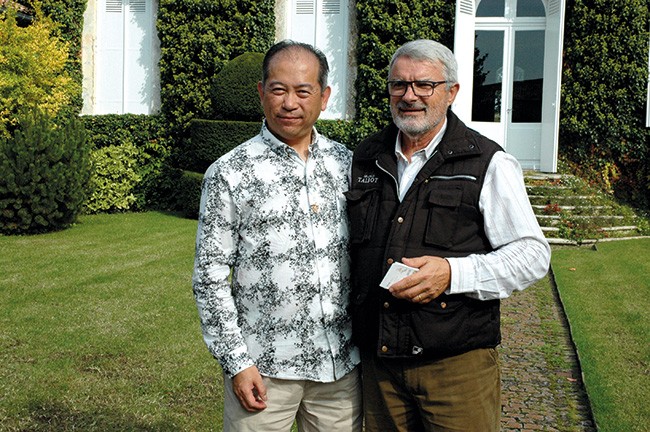
First visit, Château Bernadotte, owned by Antares Chen, CEO of the Hong Kongese group King Power Group, after it has been the property of Château Pichon Longueville Comtesse de Lalande (Group Champagne Roederer) from 2008 to 2012. A 62-hectare estate and a charming residence dating back 1860 whose name Bernadotte is closely linked to the crown of Sweden.
The 45-hectare vineyard extends over a beautiful terroir of gravel and sand as well as clay and limestone soils, mainly planted with Cabernet with a density of 10,000 stocks/hectare alike its prestigious neighbouring classed Grand Crus. And something that surprised the sommeliers, the map of the DNA of the soils of each plot they are shown by general manager Guillaume Mottes, a genuine tool for a precise work in the vineyard. Another interesting topic: not manual but mechanic harvest done by a machine of the latest generation the estate invested in two years ago. It picks only the ripest berries and perfectly adapts to the crop while fully respecting the vine. The traditional vinifications are done in stainless steel vats. One peculiarity, the existence of underground blending vats to ensure consistent quality from the first to the last bottle.
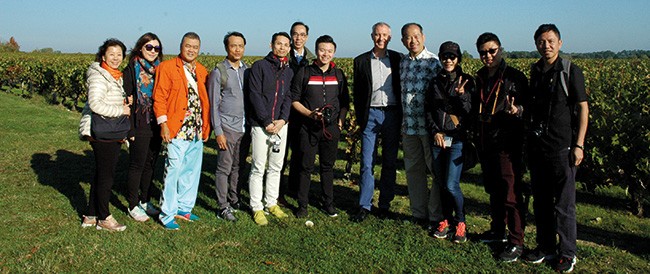
On the wines’ side, Guillaume Mottes chose to present the iconic vintages of the various periods of Bernadotte. First Bernadotte 2005, recognized as very classical with marked tannins, then a 2010 vinified by the Roederer team in which we notice an evolution to more fruitiness and silkiness.
As for the 2012 it bears a new label on which the royal coat of arms becomes a real distinctive sign, an important element for the Chinese consumers who are sensitive to the packaging. Other vintages tasted: 2013 with a more classic nose, and 2014, first vintage crafted by the new team consulted by Hubert de Boüard to raise the brand Bernadotte at the level it deserves. A discovery tasting for the sommeliers in a property where “we always take risks to remain very good in each vintage” says Guillaume Mottes.
Second stop-over of the day, Château Lascombes, one of the largest vineyards among the classed growths of 1855 with 112 hectares in the Margaux appellation. An estate marked by the 10 generations of owners who succeeded each other since the 17th century and recognizable thanks to the elegant profile of the imposing castle. There we are welcomed for a vertical tasting of 2005 to 2010, then 2016 of Château Lascombes (2nd classed growth of Margaux) and hosted by Nelson himself. He stressed on the complexity of these wines in which finesse and smoothness combine in the palate with fine tannins. And though they prefer 2005 the sommeliers appreciate the character and style of this very fine wine through the different vintages.
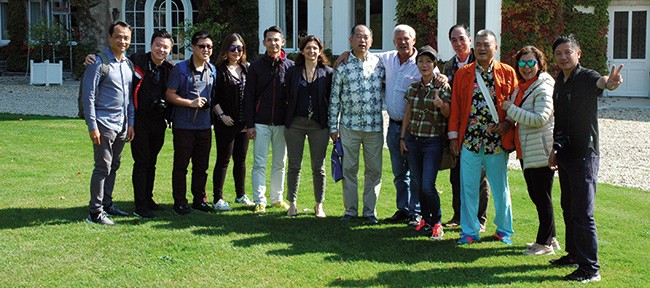
In the meantime a morning of picking is ending, offering the opportunity to share the harvesters’ lunch (a hundred people) with general manager Dominique Befve. A convivial moment of discussions about the transformations undertaken since 2001 when the estate has been taken over by Colony Capital then MACSF in 2011. The restructuration of the vineyard (50% Merlot, 45% Cabernet Sauvignon and 5% Petit Verdot) for a perfect match between the soils, the varietals and rootstocks, the reduced yields, the reorganization of the vat house to respect plot selection, three sortings including one optical sorting during the harvest, cold pre-fermentation maceration to get a more intense colour and a better complexity of the aromas, daily degustations during the post-fermentation maceration…
The whole process being supervised by Michel Rolland, consulting enologist.
Last works undertaken: the opening in summer of a beautiful shop to welcome the visitors. For the sommeliers Château Lascombes is a good example of a great Medoc property with a strong tradition resolutely forward-looking in the name of excellence.
Between Pauillac and Margaux, Saint-Julien Beychevelle, 11 classed properties including Château Talbot, owned by the Cordier family since 1917. We are in the Saint-Julien appellation on a very homogenous terroir of 900 hectares of vines along the Gironde estuary. Château Talbot covers 110 hectares out of which a confidential surface area (5 ha) of white grapes.
The harvest of the Cabernets is in progress. An operation catches the sommeliers’ attention: gravity sorting of the berries of grape in a 7-meter long Tribaie Amos table that only some thirty estates in Bordeaux have.
The visit continues with the wooden vats used for the vinification of the best grapes, a conscious technical choice. And at last the “impressive and spectacular” barrel cellar dixit Nelson, an architectural challenge with giant concrete pillars looking like a forest and that can host 1,800 barrels in optimum elevage conditions.
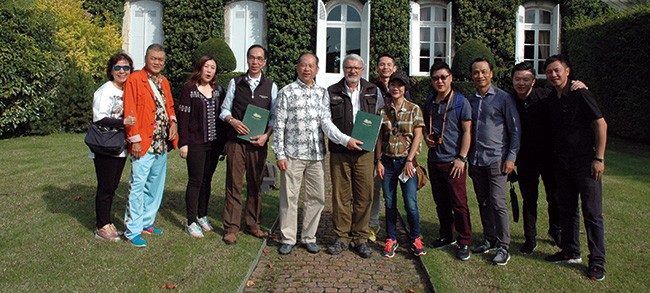
For the tasting, general manager Jean-Pierre Marty proposes a vertical degustation of Château Talbot (Saint-Julien For the tasting, general manager Jean-Pierre Marty proposes a vertical degustation of Château Talbot (Saint-Julien – 4th classed growth of 1855) from 2005 to 2015. But, something quite unusual, we start with 2015. Though for a sommelier the order does not matter Jean-Pierre Marty “prefers to start with the easiest vintages to get better prepared to taste the oldest”. A journey back in time to appreciate the characteristic style of this very fine Saint-Julien with supple and silky tannins and an aromatic freshness very present in the older vintages like Nelson notes in the 2005. This vertical tasting is a practice that very much interested our young sommeliers to learn how to differentiate the vintages and evaluate the work done on each wine. Like the blends with the addition of 3-5% Petit Verdot according to the year or the typicality of the 200 barrels used for each vintage of the grand wine (5 to 7 coopers and 10 in trial every year) to mention but only these two examples. A picture before Nancy Bignon Cordier’s beautiful house and we headed for Margaux.
It is the end of the afternoon, the sun is setting behind the vines of Margaux … The beauty and quietness of the place are breathtaking. Standing in the lovely garden in front of the 17th-century residence (rebuilt in 1904 after a fire), we are presented Château Rauzan-Segla, property of Chanel. 72 hectares planted with the 4 Bordeaux varietals with a high percentage of Cabernet Sauvignon, in a “puzzle, mosaic and patchwork” and with the heart of the vineyard lying on the famous Terrace 4, a wide stretch of gravels in a thin layer of clay with a naturally drained poor soil. These vines produce the grapes used for the grand wine, and all around, satellite plots of land with different natures of soils carefully listed. This diversity of soils and varietals, worked with a perfect respect for the terroir, is at the origin of the complexity of Rauzan-Segla’s wines that our sommeliers discovered through the tasting of three vintages—2010, 2006 & 2005—with general manager Nicolas Audebert. The opportunity to talk about what a sommelier should tell when he presents a wine to his customers: not a technical description but his perception of the estate and his own emotions. Elements that are all the more important that wine in China now is something purchased by consumers eager for history, advices and Internet.
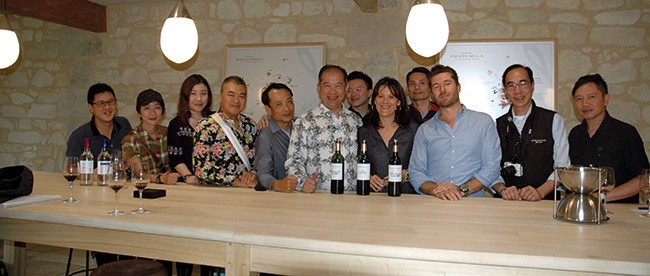
The right structure and elegance, plenty of aromas, velvety and silky tannins, freshness and ageing capacity are some of the qualities stated by Nelson about this grand wine, an emblem of the Margaux appellation and another lovely discovery for the sommeliers.
Last stage of this day in Médoc, a tasting and a convivial dinner at Château Clauzet in Saint-Estèphe. We are invited by Maurice Velge whose adventure with Château Clauzet and Château de Côme started in 1997 as the achievement of a dream, “to give substance to my passion for wine”. Starting with 10 hectares in the beginning the estate now totals 30 hectares (23 for Clauzet and 7 for Côme) neighbouring the greatests. The search for the best terroirs of Saint-Estèphe and the implementation of quality standards worth the greatest crus of Medoc have been the guidelines of Maurice Velge and his team’s work for 20 years. We are welcomed by José Bueno, the vine and wine specialist at Clauzet, with a solid experience as he formerly was the cellar master at Clerc Milon and D’Armailhac. And we did not talk about techniques but about a philosophy because, to José, “the final quality of a wine is the achievement of a long series of careful gestures, in the vineyard and in the cellar”. The work in the vineyard by a skillful qualified team, hand picking for a perfect maturity of the grapes plot after plot, made-to-measure vinifications in concrete vats in a quest for the perfect balance, elevage adapted to each vintage… all is done with a perfect control at each stage.
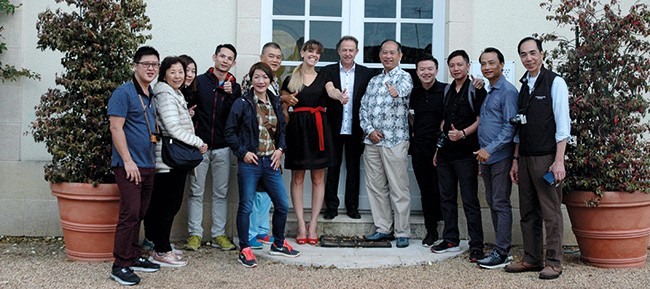
Evidence of the quest for excellence is obvious at degustation. First Château de Côme (Saint-Estèphe) with the 2008 and the 2015 with a high proportion of Merlot in the blend. A lovely freshness and aromas of tobacco in the 2015. Then Château Clauzet (Saint-Estèphe), Cabernet Sauvignon dominant, with 2008, 2012 and 2015, beautiful examples of balance. The tasters unanimously praised the 2008 for a food and wine pairing based on fatty Chinese dishes. And the day ended in Maurice Velge’s dining room for a convivial dinner, in the purest French tradition.